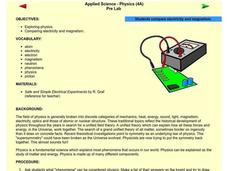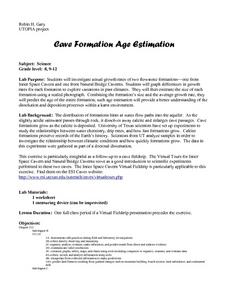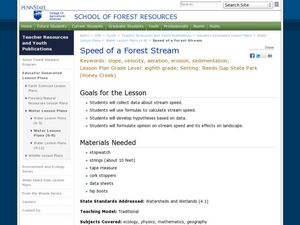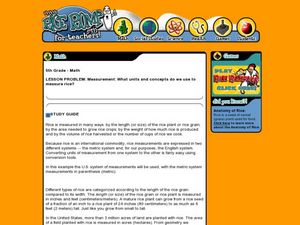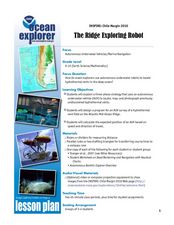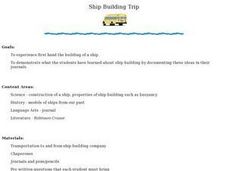Curated OER
What’s That, I Can’t Hear You?
Students investigate forms of energy as well as light and sound. In this science lesson, students participate in hands-on activities that require them to evaluate how sound affects astronauts in flight. A video of this lesson being...
Curated OER
Shells Around the World
Students research a geographical region that contains shells. For this shells from around the world lesson, students take a field trip to a local shell shop (if possible) and then work in groups to research a geographical region...
Curated OER
Electricity and Magnetism
Fourth graders compare electricity and magnetism. In this science lesson, 4th graders discuss the concepts of electricity and magnetism and brainstorm examples of electrical and magnetic forces.
Curated OER
Those Before Us
Students examine medical pioneers and identify their characteristics. They survey their contributions to the medical field and society and present persuasive argument for or against modern medical pioneers.
Curated OER
"Write" Answers
Learners examine the Q.& A. articles found each week in Science Times, focusing on how the answers are presented in a clear and logical way, as well as the relevance of understanding science's roles in our daily lives.
Curated OER
Magnets
Students explore the science of magnets and how magnets work. They conduct a series of fun experiments and magnetize objects and demonstrate how magnetism operates right through other materials.
Curated OER
Cave Formation Age Estimation
Students investigate growth rates of flowstone formations. They view a virtual field trip and discuss how flowstones form. They observe the cave fieldtrip and predict the growth rate for a cave formation. They graph growth rates and...
Curated OER
Evolutions of Pottery
Learners study the history and importance of clay and pottery. They observe a video dealing the kiln. Students explore ideas for improving construction of pottery. They demonstrate a variety of construction methods and identify the...
Curated OER
Career Exploration
Young scholars create a pamphlet, brochure, handout, or poster about a career in the marine sciences. In this marine science instructional activity, students use the Internet to research a marine science career. They create a printed...
Curated OER
Speed of a Forest Stream
Students study stream speed. In this stream speed lesson students complete an activity and formulate an opinion and study its effects.
Curated OER
Life Giving Rivers
Students examine the world's rivers in this six lessons unit which mingles science with social studies. The dynamic forces that create erosion in nature are also seen as habitats and ecosystems that are affected by environmental and man...
Curated OER
What units and concepts do we use to measure rice?
Fifth graders look at different ways to measure rice. In this rice measurement lesson, 5th graders see the metric and customary measurements. They discuss how rice is measured by length, area of the field, weight, volume and yield.
Curated OER
The Ridge Exploring Robot
Students study about an autonomous underwater vehicle and explain the strategies that it uses to locate and map hydrothermal vents. In this marine navigation lesson students design a program for an AUV survey.
Curated OER
Dirt Life
Students select and collect soil samples from a variety of locations (schoolyard, home, etc.). They do this lab after an interest-generating discussion about "dirt" and microbes. Students make a dilution in sterile water, plate it on a...
Curated OER
Eyewitness Dinosaur Video Quiz
In this science worksheet, students use their notes from the Eyewitness video on dinosaurs to help them select the correct answer for each question. They identify various types of dinosaur fossils found and their specific names.
Curated OER
Arthropod Data Collection
Students describe the life cycle of various bugs as well as their predators and feeding habits. The class participates in a discussion of the various methods scientists use to gather data including research and experiment. After...
Curated OER
Water Properties of the Great Salt Lake
Fourth graders examine the ecosystem of the Great Salt Lake in this two-part lesson, completing a KWL chart before and after the field trip to the site. While there, they draw and write about their observations. To test for buoyancy,...
Curated OER
Observations From the Past
Ninth graders explore direct and indirect evidence. For this astronomy lesson, 9th graders investigate the contribution of early astronomers to their field. They create a model of the solar system.
Curated OER
Water Quality Survey: Monitoring the Sustainability of Pigeon Creek
High schoolers research the History of Pigeon Creek (or any watershed in your area). In this environmental science lesson plan, students conduct field tests such as pH and nitrates. They collect data and compare what they collected with...
Curated OER
Ship Building Trip
Students travel to a ship building plant to see how they are built. They enter into discussion and writing about the task of the building. This lesson is multiple intelligence in design and valuable because of the real life exposure.
Curated OER
Deer Yard Investigation
Students study the survival strategies of deer during the winter. They investigate the resistance behavior of white tailed deer to winter conditions after discussing migration, hibernation, and resistance as survival techniques. They...
Curated OER
Pharaoh Mountain Hike: Investigating Adirondack Life Zones
Students hike a local mountain and examine its life zones. They measure various components at each zone and collect leaf litter at the sites. At the mountain top, students make descriptive observations and complete a handout about the...
Curated OER
Investigative Case - "Swampeast Missouri"
Students explore wetland hydrology and biology and decide whether or not to restore a wetland or retain dams and drainage systems. They examine the complexity of decisions regarding wetland restoration as well as investigate viewpoints...
Curated OER
True North, Magnetic North
Young scholars explain why compass angles need to be corrected for regional magnetic variation. They observe the difference between magnetic and true north. Each student measures the angle of variation for a town in a different state.


